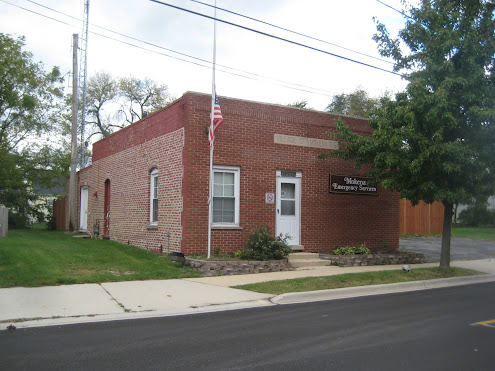In the heart of Mokena there stands a small, nondescript building. Simple in its construction, it’s not likely to ever win any architectural praise. With its weathered red bricks, and stone inscription standing sentinel over the front entrance, the structure has a place in our village’s history that’s nigh impossible to overstate. Nowadays bearing the address 10940 Front Street, and home to Mokena’s Emergency Services and Disaster Agency, in years past it housed our first village hall. For well over a century, mayors, trustees, and simple townspeople have passed through its portal.
To fully understand the beginning of this place, one should first step back to 1880. In the spring of that year, rural Mokena officially incorporated as a village, leaving behind a failed try from a few years previous. After preliminary odds and ends like the licensing of saloons and laying drainage tile along the streets were carried out, the village solons saw through the purchase of a newly vacated lot on Front Street, one door east of Division Street. The deal was made official on May 8th, 1884, and over time, this patch of property hosted all the trappings of a municipality, such as a tiny wooden jailhouse, an enclosure that held the fire brigade’s hoses and cart, and starting in 1898, Mokena’s first water tower.
Even after several decades of improvements in town, the community still lacked a proper village hall. First mayor Ozias McGovney and his board of trustees convened in a harness shop on Front Street, while future meetings were held in places as varied as the dank basement of Charles Schiek’s saloon or the waiting room of the Rock Island railroad depot. By 1916, mayor George Hacker and trustees Charles Liess, Emil Krapp, John Groth, Albert Braun, John Nielsen, and Edward Schenkel were coming together at the Mokena Hall, a rambling multi-purpose building that stood at the current site of Avalanche Jewelry.
At this time, the village hosted around 400 residents, and town leaders were in the market for a permanent home. When Mayor Hacker and his trustees assembled on February 2nd, 1916, the subject came up of building a permanent structure to house a council chamber, a sturdier jail than the one already in existence, and a better space for the firefighting accoutrements. After word got out among Mokenians that the board was looking to build, there was concern by some that taxes would go up, but this notion was quashed by village clerk Bill Semmler, who was also the local correspondent to the Joliet Herald-News.
To get the ball rolling, the village had to raise a bond of $4,600 to build the new town hall and simultaneously carry out a water main extension to some homes in town. The question went to referendum on April 18th, 1916, when the construction question passed 109 to 21 votes. The poll was unique, in that Mokena women were able to cast their votes, having been granted limited suffrage three years previously by the state government.
Mayor Hacker, a contractor by trade, donned the hat of his day job and drew up some plans for the town hall, one that the Herald-News announced with restrained excitement would be “equipped with electric lights”. The village board accepted bids for construction of the new building, but all were rejected in June as being too expensive. At the end of July, concrete mason and Front Street resident Julius G. Oswald started work on the structure’s foundation, but before proper construction could begin, a slight problem had to be taken care of, namely the removal of the old jail which still stood on the village property. The wooden shack was unloaded to local farmer Dick McGovney for $20, who then put rollers under it, and had it dragged south by horsepower. He placed it on the south side of LaPorte Road, where it became his rustic home.
The summer led to another hitch, when the high temperature caused several cases of heatstroke in town that August, leading labor on the town hall to be temporarily suspended. Work under Contractor Oswald and his crew continued into the fall of 1916, with three jail cells being shipped from Detroit at the end of October. They were a snug five feet wide, and six feet, six inches high. The first village board meeting was to be held in the new council chamber in November 1916, but despite rushing by Julius Oswald and his crew, it was delayed until the very end of the year. Hiccups continued until the last second; when the building’s electric juice was first switched on, a light in the firehose’s cart room blew out, and a 100-watt nitrogen bulb in the council chamber was a dud.
Used today by the Emergency Services and Disaster Agency, this quaint building housed Mokena's village hall and jail along with storing firefighting equipment when it opened in 1916. (Image courtesy of Richard Quinn)
The historic record is foggy, but the last village board meeting of 1916, held on December 27th, was probably the first to be held in the new town hall. Mayor Hacker and every trustee were present, with rather mundane business being transacted, namely insuring the building and paying off those who had constructed it. After decades of use at this site, the village hall relocated to Carpenter Street in 1976, and ESDA moved into to the historic Front Street building in 1993, where it still resides. The small, unpretentious edifice has been witness to a multitude of Mokena’s history over the last 100 years, and in the hands of a caring community, it may behold another century of usefulness.




